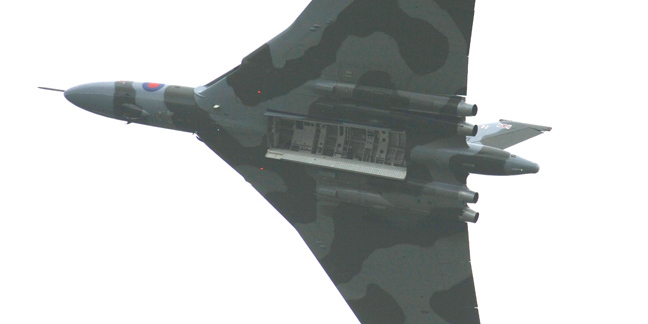Dutch Spies Helped Britain’s GCHQ Break Argentine Crypto During Falklands War

Avro Vulcan bombers were used during the Falklands … Pic: Phil Holding
Dutch spies operating as a part of a European equivalent of the Five Eyes espionage alliance helped GCHQ break Argentinian codes during the Falklands War, it has been revealed.
Flowing from revelations made in German-language news reports earlier this year that Swiss cipher machine company Crypto AG was owned by the CIA and German counterpart the BND during most of the Cold War, an academic paper has described the Maximator alliance which grew from the Crypto AG compromise.
Authored by Professor Bart Jacobs of Radboud University Nijmegen in the Netherlands, his in-depth article, titled Maximator: European signals intelligence cooperation, from a Dutch perspective shines a light on Cold War security and SIGINT from an oft-ignored perspective, at least in the Anglosphere.
As related by Jacobs, Maximator was founded in 1976 and brought together Denmark, France, Germany, Sweden, and the Netherlands as a northwest European version of the Anglosphere’s Five Eyes. The latter comprises Britain, America, Australia, Canada, and New Zealand – what Sir Winston Churchill called the English-speaking nations.
Named after a Bavarian beer brand popular with BND spies at the agency’s Munich HQ, Maximator came about in part because of “the emergence of signals intelligence via satellites, which required substantial investment” to forcibly decrypt. None of its members felt able to tackle the subject on its own.
Maximator, GCHQ and the Falklands War
Dutch eavesdropping agency TIVC was one of the key parts of the Maximator alliance, playing a very important role in helping Britain during the 1982 Falklands War. When the Argentine junta invaded the British South Atlantic island on 2 April, Britain assembled a military task force which sailed and flew halfway around the world to expel the invaders and liberate the local population.
Among Britain’s means to defeat the Argentinians was good old-fashioned signals intelligence, or SIGINT: in everyday English, breaking the crypto on the Argentine military’s communications so their plans and intentions could be read. Such work is in the DNA of GCHQ, which grew out of the Government Code and Cipher School in WWII.
Yet GCHQ didn’t have a full insight into the cipher machines the Argentinians were using. At the time, those were supplied by Crypto AG. Unfortunately for the South Americans, the models they had – HC550s and HC570s – included “rigged” algorithms, deliberately undermined “by the BND and the CIA, via their ownership of Crypto AG”.
“A directly involved Dutch source states that at that stage a specialist from TIVC travelled to GCHQ and explained how the HC500 Crypto AG devices for Argentinian naval and diplomatic communications worked; subsequent solution of the ciphers was left to GCHQ itself,” said Prof Jacobs, who spoke to multiple former Maximator personnel while writing his paper.
We’re reading their comms, said MP at war’s outbreak
Yet Argentina figured out that their comms were being eavesdropped upon, which Prof Jacobs attributed to a statement in the House of Commons by then-Labour MP Ted Rowlands, who still sits in the House of Lords as Baron Rowlands to this day. While criticising Conservative Prime Minister Margaret Thatcher on 3 April 1982 – the day after the invasion – Rowlands told the House:
At the time no MPs appeared to notice the significance of Rowlands’ “disclosure”, as the Hansard record shows. Historian Hugh Bicheno, in his 2006 book Razor’s Edge: The Unofficial History of the Falklands War, excoriated Rowlands, writing that “this was the precise equivalent of publicly announcing, during World War II, that the Allies had broken the Enigma system used by the Nazis.”
Yet Prof Jacobs, in his history of the Maximator alliance, speculated that firm corroboration for the Argentinians may have come from a captured British pilot who was shot down while carrying “information that could only have been obtained via compromised communications”.
A list of British aircraft lost during the Falklands War reveals a small number of likely candidates. Although the one pilot actually taken prisoner by the Argentines, then-Flight Lieutenant Jeffrey Glover, said in 2007 he was not interrogated after being fished out of the icy South Atlantic when shot down in May 1982 during a recce mission, it is possible that other British aircraft shot down over land may have contained maps or other documents that Argentinian forces could have recovered.
The public confirmation of Maximator’s existence will continue to puzzle and intrigue historians, researchers and those with an interest in Cold War cryptography and SIGINT for years to come. ®
Sponsored: Webcast: Ransomware has gone nuclear
READ MORE HERE
